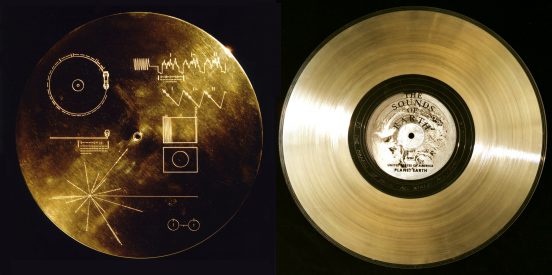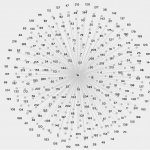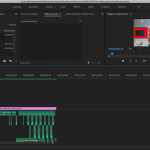I first heard about the Voyager Golden Record during my undergraduate, where my friends and I would have faux-philosophical debates long into the night (our ideas were deep, but still a little murky at the time). I remember researching the symbols placed on them, and trying to ascertain whether they really would capable of transferring information to extraterrestrial life that may be different in a way we could never conceive. I also remember trying to determine if the things that had been selected for the records could be considered a good representation of human life and culture in all its diversity. The songs selected for it, however, I never spent much time on so it was a great joy to have a more focused activity to spiral into now.
After a week of listening to these songs, I realised that choosing 10 was a difficult number. 5 I could easily identify, but pushing it up to 10 became a challenge. Furthermore, with the focus of this task being the songs, I decided to select them on their own merits rather than looking at which 10 I would select in combination with the other items on the record. This selection of music was interesting, but it does carry a predominantly Western gaze. Whilst the record was sent into space at a time where technology was still in its infancy and the world was not nearly as connected as it is now, it was still slightly discouraging to see that something tinged with a colonial undertone has been sent into space as a representation of all humanity. It made me think about what may be on this record if it was remade and sent off in the world of today. Do you have any thoughts on what would change, or things we should definitely include/not include on a 2020 version of the Golden Record? All sounds, songs, and related audio welcome.
Selected Songs and Motivations
Alright, so lets get into the task itself! I selected songs that I personally enjoyed listening to, and that I think aligned with the philosophy of representing something core about life and culture on earth. I opted to create some sub-categories for meaning, in which songs that have a relationship between their motivations have been placed under. The test has been completed, so lets proceed.

Songs from the Differently-Abled
These two songs were written by individuals that were deaf (Beethoven) and blind (Johnson) but still created music that has had a lasting impact on humanity. I felt this was an important reflection on human strength and resilience to include in my curation of 10.
Symphony No. 5 – This classical piece is recognised by various different audiences across the world. It’s been used in so many different things we have created, from movies to ads to playful pieces of media at home. This pervasiveness of sound is rare, and I think also melodically dynamic and interesting enough, to be a good representation of the creativity of humans and the role it plays in culture and life.
Dark was the Night – A blues piece is expected to tie into human emotion, but the sounds and moans in this piece are truly evocative. It shows how human emotion can be carried through sound and shared, and how powerful the emotions of sadness, loss, and loneliness are. The idea of a song from a blind man singing about the darkness of night being sent to float around space for eternity is also so poetic it felt necessary to include it.
Global Societies
This is not the ideal selection to really represent the diversity of human culture on earth, but I wanted to select some of my personal favourite two songs from the record to try capture the variation in sound and music across societies.
Navajo Indians: Night Chant – Percussive human voices mixing with drums is such a resonant call, that feels basal and primal in all the best ways. The interwoven speech and sound is unfiltered and raw, and in combination with the human voices offers a snapshot of lives lived in connection to the earth. It is comforting and powerful, reminiscent of a heart beats and steps and the repeated habits of human lives.
Ketawang: Puspawarna – This piece also has mixed speech and sound, but in a way that is light, haunting, and chorally melodic. In contrast to the night chant, it speaks to the fluidity and lightness of life and the beauty that exists in fragility. The fact that Javanese is a stratified language, and that this song had a new orchestral composition to include all stanzas in a length appropriate for the record, also shows how humans adapt and bend to new challenges.
Iziel je Delyo Hagdutin – This piece blends together voice and instrument seamlessly, where human sound mimics or matches aspects of the world around it. This harmony isn’t necessarily comfortable to listen to, but it does cut through everything else; it is all-encompassing. It also carries a lot of emotion through the lack of restraint in voice, and the confidence required to do that shines through in the song. In this way, it almost reflects the strength of the human spirit and the power we have in choice to create and share things.
Masculine and Feminine; Isolation and Groups
The representation and role of gender in human societies varies, but does often carry a powerful role. These two songs are sung solely by a gendered individual/s, for environments which are very much tied to societal roles and understandings of that gender in the Western world. The Song of Marriage is sung by a girl, and The Table Song (sung before war) is sung by men. It also shows the fluctuating states of isolation and groups that humans move between, and the power and vulnerability that comes from both states.
Song of Marriage – The rises and falls of voice in this song are delicate and beautiful enough to warrant a selection of this song, but there is a greater depth here too. The lone young female voice singing a song of marriage shows the vulnerability of femininity, but also the resolve and strength required of an individual to make a partnership work. It’s a completely different kind of battle cry, filled with acceptance and gentleness from the move between single and pair that represents a core tenant of human bonding and relationships.
Chakrulo (Table Song) – The wavering singers over a backing low chorus of voices is breathtaking, and a wonderfully motivational side of masculine identity. It carries the notion of group unity, solidarity, and protection but without aggression or force despite being a song sung before battle. Because of this it acts as such a flag of the human drive to protect and fight, but due to care rather than anger. It represents the might of working together for common cause, and the beauty of loving enough to protect and sacrifice.
Creation of Music with Tools
Usage of tools has been an evolutionary step that really deviated us from various biologically similar relatives. It is what has allowed the development of industry, and technology, and is a foundational aspect of why we live in the world we do today. For this reason I thought that songs made purely with tools that don’t include the human voice as a central part of the sounds would be important to include.
Senegal percussion – Percussive drums have been with humans as part of our lives, cultures, and societies a very long time. They are versatile instruments, often made with materials that we live and work with closely (trees and animal skins) but that require good knowledge in order to create. This piece is visceral, and unbridled, it carries power and motivation and joy all wrapped into steady percussive beats.
Tsuru no Sugomori – Using human breath to create wind-based sound through tools we have created is much a magical mode-bending. Rather than using breath for speech, using it to create melody and music through a tool epitomises how human expression is multi-modal. The song produced is also still able to communicates emotion and idea successfully, even without words.
Running Water – Mimicry of our environment using tools and sound is a beautifully human endeavour, and the way tin percussion and strong was manipulated by human hands to represent a flowing river is beautiful. The melody itself is pleasant to listen to, but when considered in combination with the tools used to make this song and the part of the natural world it is trying to represent it morphs into a reflection of how humans attend to certain things and try to make them their own. Even if it is just through an abstraction of their own making.
Music, Sound, Society, and Culture
There is so much richness in looking at music/sound as a reflection of society and culture. These are two amazing playlists on YouTube by Vox which have some real video-essay gems on the topic. Would highly recommend a browse, clicking on some of the videos with titles that interest you!






Rebecca Hydamacka
July 4, 2020 — 2:09 pm
Hi Jamie,
Wow! I hadn’t even considered abilities of the musicians but did include selections from Beethoven (5th) and Johnson (Dark ) on my own curation. I included Dark was the night” because it was so bluesy and soulful and Symphony No. 5 for its powerful opening. It is amazing how despite different methods some of our lists are so similar but for different reasons. And now I think I will go did up my music and see if I have Suite No. 1 in G Major. Thanks for the deconstruction.
Jamie Ashton
July 16, 2020 — 11:43 pm
Hey Rebecca,
Woo. What a delayed response from my side – sorry! I do agree that its interesting that the same songs were chosen for completely different reasons! Another thing the data visualisation can’t tell us, I guess 🙂
Thanks for the comments